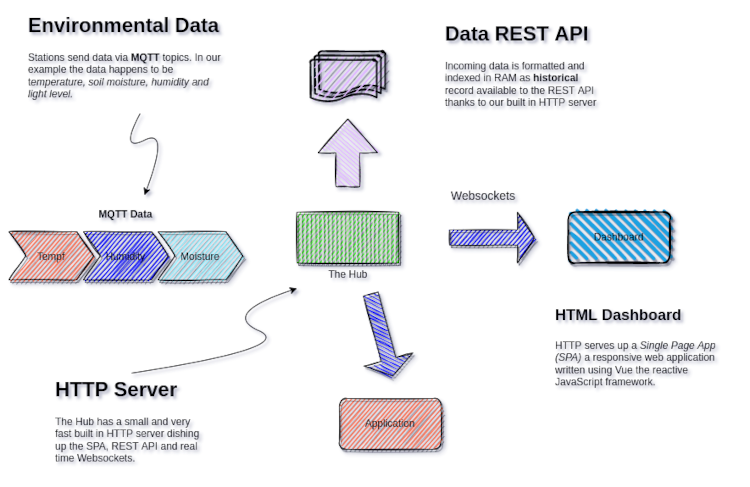
What Does OG Hub Do?
In a nutshell the Hub gathers environmental data from a network of Collection Stations using the well known MQTT Messaging protocol. The hub feeds the data to the Oraganic Gardner application, streams it real-time to dashboard users via Websockets and caches the data in RAM.
How Does the Hub Work?
The Hub is a small, fast server written in Go with the following dependencies:
- Go’s built-in HTTP Server to serve HTML
- Go’s built=in HTTP Server to serve REST API
- Websocket Library for real time data to dashboard
- MQTT Eclipse MQTT Library
The software running on the Hub can be called a Micro-service. Go’s built in HTTP server is small, robust and fast allowing us to easily add a REST API and serve up some HTML and JavaScript to for our WebUI, which happens to be a Single Page App
The MQTT and Websockets libraries, like Go’s built in HTTP library, are also robust, fast and small allowing us to build this sophisticated application and also keep it small, robust fast. YEA!
As matter of fact, it is so small and fast, it is more than happy to run on a Raspberry Pi!
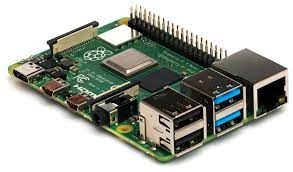
Readers, Writers and Concurrency
The Hub is really a moderately sophisticed data multiplexer made up of multiple concurrent readers and writers. The cuncurrency is perhaps the most interesting design challenge of this software.
The Hub handles concurrency with features built into the Go programming language: Go Functions and channels which will be described in a future article.
Todo write article on how hub uses channels and go functions
Current Features (MVP)
The 1st Milestone of the Organic Gardener IoT Project has been completed. The list of supported features are:
- Collect environmental Data via MQTT
- Cache collected data in RAM.
- HTTP server to provide a REST API
- HTTP server to serve the Dashboard webapp
- HTTP server enhanced with Websockets to stream data live
Coming Soon …
In a future phase of the project we will add an option to save data in a persistent Database. We will discuss various choices between SQL variants (MySQL, Postgres), Mongo and application specific databases like InfluxDB and Prometheus.
Demo of the Hub
This section will demonstrate using the REST API to retrieve data from the Hub has collected. To pull this off we are going to Mock a Collection or two by sending “fake” data using the mosquitto_pub client.
Fire Up The Hub
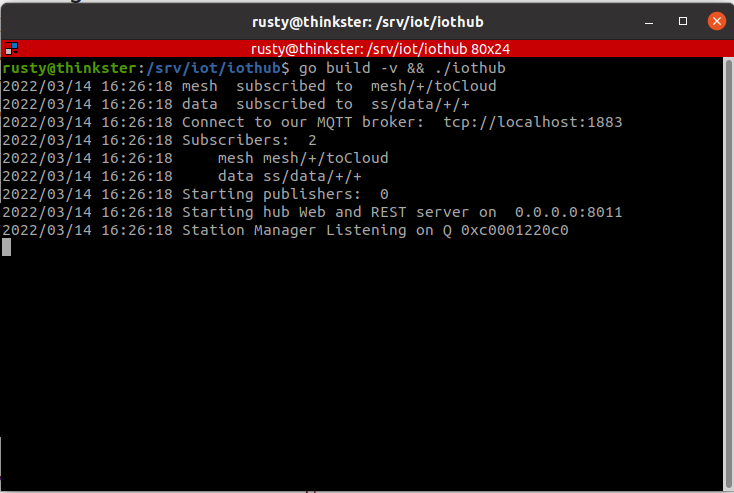
Above is a screenshot of the logs displayed when the Hub has started. If we read logs beging with the first we will find that the hub has:
- Subscribed to the MQTT mesh network channel
- Subscribed to the MQTT data channel
- Connects to the MQTT broker on localhost
- HTTP Server starts up listen on port 8011
Notice the MQTT subriptions using the ‘+’ wildcard character allows the subscriber to gather data from many sources with a single subscription.
The topic path form is ss/data/{stationid}/{sensorid} where the
{stationid} and {sensorid} are variables that match the
sub-strings in segments 3 and 4 of the topic
MQTT Wildcard Subscriptions
MQTT supports wildcard subscriptions allowing the Hub to subscribe to ALL data channels even without knowing the stationID’s or sensorIDs before hand.
By subscribing to /ss/data/+/+ the Hub will recieve data from
every station and sensor on the network.
Publishing Test Data
We are going to mock a Collector by publishing fake environmental data using the cool MQTT publishing utility mosquito_pub.
% mosquitto_pub -t ss/data/10.11.1.1/tempf -m 98.6
We will fake data from sensor tempf to topic
ss/data/10.11.1.11/tempf the value of 98.6 using the
following command:
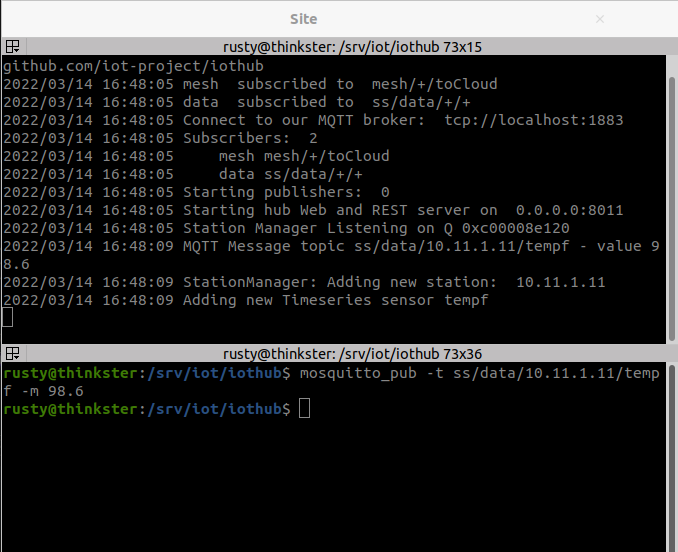
In the above screen shot mosquitto_pub published the temperature
in farenhiet to the topic ss/data/10.11.1.11/tempf where the CS
station id is represented by 10.11.1.11. Likewise, the sensorID
is represented by the string tempf. The value passed in 98.6
degrees farenhiet.
We can see the Hub recieving the data and parsing the stationID and sensorID from the topic string. The data is parsed, formatted and temporarily saved in RAM.
When data periodically arrives, the Hub will quickly extract the following elements of the data point.
- Station ID probably in the form of an IP or MAC address
- Sensor data name such as: temprature, humidiy, air-pressure, etc
- Value this will either be an integer or a float64
- Timestamp when the data was sampled.
The data is reformatted and stored as a time-series in RAM. Let’s have a look at the REST API that can be used to access the environmental data.
Using the REST API
Another screenshot is in order. This time I’ll use curl to call the data REST API to retrieve the one piece of data we have collected:
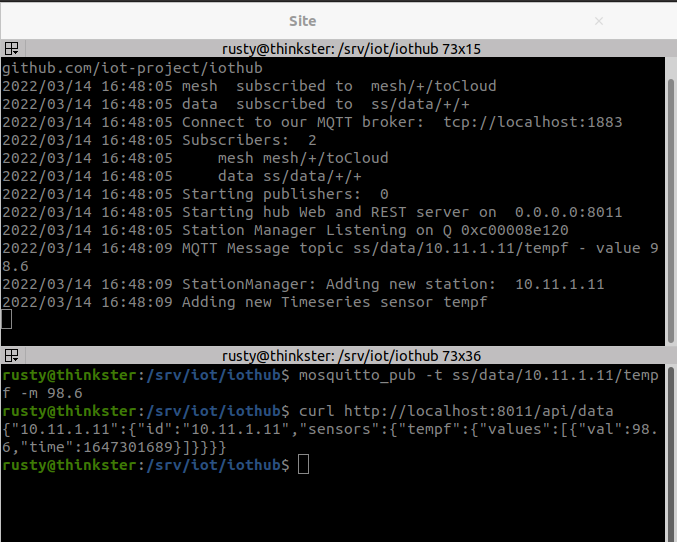
Notice the curl command in the bottom screen, the data has been
returned in full JSON format. This single data point looks like
this when pretty printed.
{
"10.11.1.11": {
"id":"10.11.1.11",
"sensors": {
"tempf": {
"values": [
{
"val":98.6,
"time":1647301689
}
]
}
}
}
}
Complete REST API
The Hub provides a REST API allowing other programs to access datasets from the Hub for various applications. Some of the important REST API endpoints are:
- GET /stations
- GET /station/{stationid}
- GET /data?stationid={stid}&sensor={sens}&start={start}&end={end}
- DELETE /data?stationid={stid}&sensor={sens}&start={start}&end={end}
The first two gather and reply with IoT Collection Station meta data, such as the station ID, sensors hosted and performance and metrics.
The /data endpoint will return data ;-), filters can be used to
limit the response to certain stations, sensors and / timespans.
Dashboard and Websockets
Built into the Hub is a Web server capable of serving up a Single Page App (SPA) discussed on it’s own section of this project site. The Hub and Dashboard support Websockets allowing the Hub to update the Dashboard when new data arrives in real-time.
We will talk alot more about this in the Dashboard